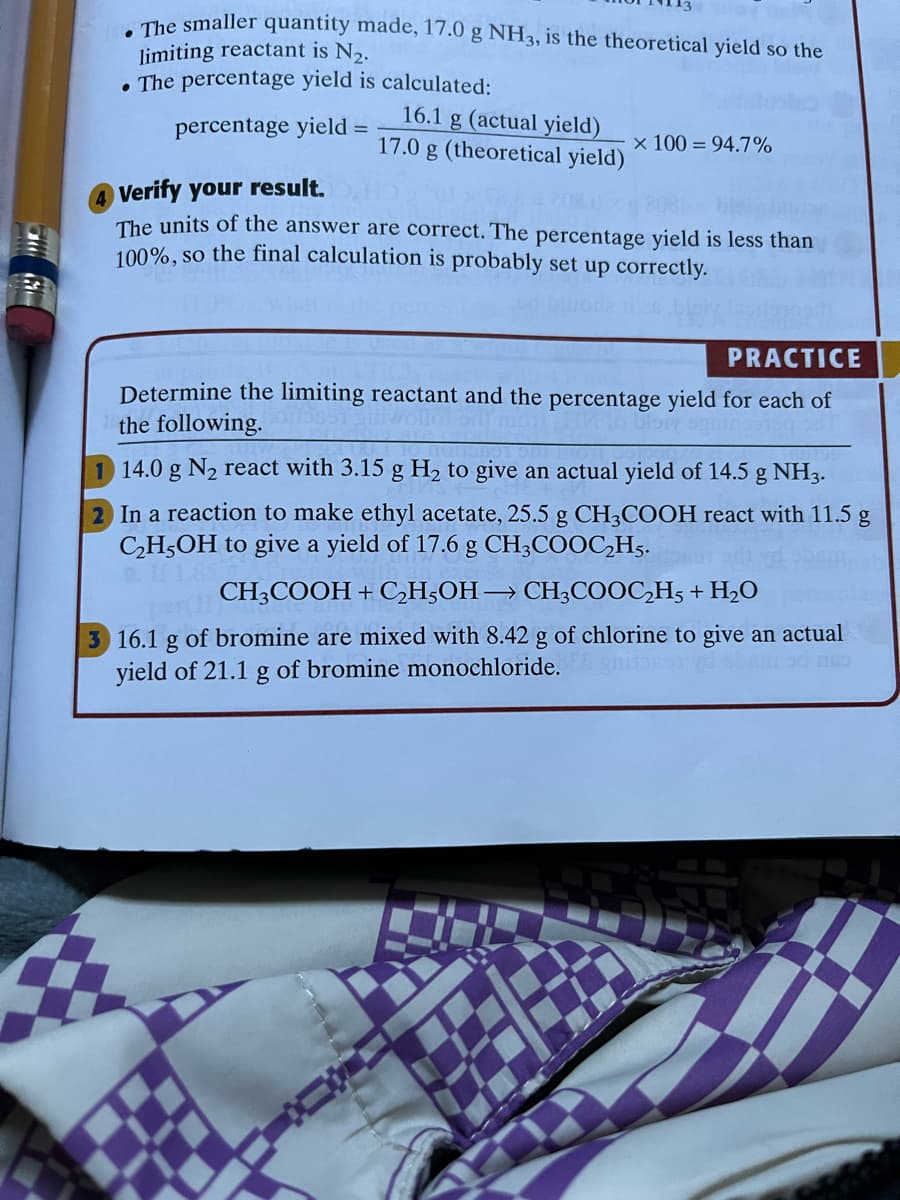In a reaction to make ethyl acetate, 25.5 g CH3COOH react with 11.5 g CH5OH to give a yield of 17.6 g CH;COOC,H5. CH;COOH + C2H;OH→ CH;COOC,H5 + H2O
In a reaction to make ethyl acetate, 25.5 g CH3COOH react with 11.5 g CH5OH to give a yield of 17.6 g CH;COOC,H5. CH;COOH + C2H;OH→ CH;COOC,H5 + H2O
Chemistry for Engineering Students
3rd Edition
ISBN:9781285199023
Author:Lawrence S. Brown, Tom Holme
Publisher:Lawrence S. Brown, Tom Holme
Chapter4: Stoichiometry
Section: Chapter Questions
Problem 4.77PAE: The pictures below show a molecular-scale view of a chemical reaction between H2 and CO to produce...
Related questions
Question
2. In a reaction to make ethyl acetate, 25.5 g CH,COOH react with 11.5 g
CH,OH to give a yield of 17.6 g CH COOCHs.

Transcribed Image Text:The smaller quantity made, 17.0 g NH3, is the theoretical yield so the
limiting reactant is N,.
• The percentage yield is calculated:
16.1 g (actual yield)
17.0 g (theoretical yield)
percentage yield =
x 100 = 94.7%
Verify your result.
The units of the answer are correct. The percentage yield is less than
100%, so the final calculation is probably set up correctly.
PRACTICE
Determine the limiting reactant and the percentage yield for each of
the following.
14.0 g N2 react with 3.15 g H, to give an actual yield of 14.5 g NH3.
In a reaction to make ethyl acetate, 25.5 g CH3COOH react with 11.5 g
CH,OH to give a yield of 17.6 g CH3COOC,H5.
CH3COOH + CH;OH→ CH;COOC,H5 + H2O
3 16.1 g of bromine are mixed with 8.42 g of chlorine to give an actual
yield of 21.1 g of bromine monochloride.
Expert Solution
This question has been solved!
Explore an expertly crafted, step-by-step solution for a thorough understanding of key concepts.
This is a popular solution!
Trending now
This is a popular solution!
Step by step
Solved in 2 steps with 2 images

Knowledge Booster
Learn more about
Need a deep-dive on the concept behind this application? Look no further. Learn more about this topic, chemistry and related others by exploring similar questions and additional content below.Recommended textbooks for you

Chemistry for Engineering Students
Chemistry
ISBN:
9781285199023
Author:
Lawrence S. Brown, Tom Holme
Publisher:
Cengage Learning

Chemistry: The Molecular Science
Chemistry
ISBN:
9781285199047
Author:
John W. Moore, Conrad L. Stanitski
Publisher:
Cengage Learning


Chemistry for Engineering Students
Chemistry
ISBN:
9781285199023
Author:
Lawrence S. Brown, Tom Holme
Publisher:
Cengage Learning

Chemistry: The Molecular Science
Chemistry
ISBN:
9781285199047
Author:
John W. Moore, Conrad L. Stanitski
Publisher:
Cengage Learning


Introductory Chemistry: A Foundation
Chemistry
ISBN:
9781337399425
Author:
Steven S. Zumdahl, Donald J. DeCoste
Publisher:
Cengage Learning

Introductory Chemistry: An Active Learning Approa…
Chemistry
ISBN:
9781305079250
Author:
Mark S. Cracolice, Ed Peters
Publisher:
Cengage Learning

Chemistry for Engineering Students
Chemistry
ISBN:
9781337398909
Author:
Lawrence S. Brown, Tom Holme
Publisher:
Cengage Learning